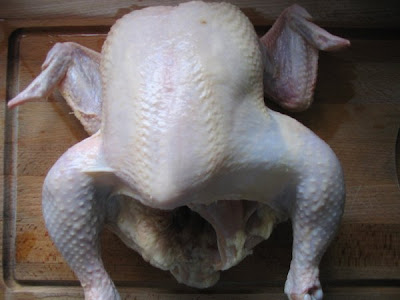Pate sucree is one of the three basic French pastry crusts (pate brisee - the all purpose crust used for pies, savory and sweet tarts, pate sucree - a sweet crust used for tarts, and pate sablee - the sandy crumbly crust). It is sweeter than the all purpose pie crust, the pate brisee, however the texture can vary. Some recipes call for creaming the butter and sugar then adding the flour, resulting in a crumbly, shortbread cookie-like crust. Whereas other recipes diverge and call for processing or cutting the butter into the flour sugar mixture, which is the same method used to create a pate brisee. This recipe uses the latter technique and yields a sweet, flaky, melt-in-your-mouth crust that is unbelievably good. I'll try the creaming the butter and flour for the next tart but I have a feeling I will be coming back to this recipe again and again.
Prebaked Flaky Pate Sucree
for an 8 or 9 inch pan
1 C flour
1/3 C confectioner's sugar
1/4 tsp salt
6 Tbsp cold butter, cut into 6 pieces
1 egg yolk
2 Tbsp cold milk or ice water
1/2 tsp of vanilla
Add the flour, confectioner's sugar, and salt together in a food processor and pulse once or twice to combined. Add the pieces of butter and pulse until the butter pieces are no bigger than a pea. Alternatively use a fork or pastry cutter to cut in the butter, or freeze the butter and coarsely grate it then use your fingers and rub the pieces into the flour. It is very important to keep the butter cold otherwise it will melt and make the crust greasy and you'll lose all the flaky layers.
Mix the egg yolk, milk, and vanilla together. Drizzle the mixture over the butter and flour mix in the food processor. Pulse again until the dough start to form large clumps. If it looks too dry add a little more milk.
Scrape the dough onto a large piece of plastic wrap and press the clumps together to form a disc. Wrap the dough in the plastic wrap and chill at least an hour up to overnight. Or store it in the freezer for as long as you want.
Preheat the oven to 375 degrees F.
Lightly flour a work surface and rolling pin and roll out the dough to into a large circle. Move the crust around often to make sure it doesn't stick to your work surface.
Transfer the dough to an 8 or 9 inch tart pan. To make this easier, drape the dough over the rolling pin and lay it over the pan. Lift the edges of the crust and gently press the dough down into the pan. Roll over the top of the pan with a rolling pin to trim any overhanging dough.
Prick the surface of the dough with a fork. Press a sheet of aluminum foil onto a crust and add pie weights, beans, or clean pennies on top. I like using pennies because they are the best heat conductor. Bake on the middle rack for 25 minutes. Remove the foil and baking weights (be careful the weights will be very hot!) and return the crust to the oven to bake for another 10 or so minutes until it is golden. Cool to room temperature before filling.













